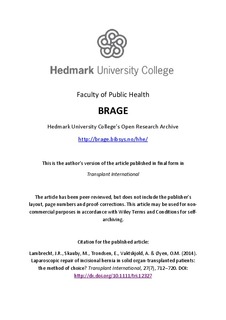Laparoscopic repair of incisional hernia in solid organ-transplanted patients: the method of choice?
Journal article, Peer reviewed
Permanent lenke
http://hdl.handle.net/11250/275120Utgivelsesdato
2014-05-09Metadata
Vis full innførselSamlinger
Originalversjon
Lambrecht, J.R., Skauby, M., Trondsen, E., Vaktskjold, A. & Øyen, O.M. (2014). Laparoscopic repair of incisional hernia in solid organ-transplanted patients: the method of choice? Transplant International, 27(7), 712–720. DOI: http://dx.doi.org/10.1111/tri.12327 http://dx.doi.org/10.1111/tri.12327Sammendrag
Background: Due to immunosuppressive (IS) therapy, incisional hernias are overrepresented in the organ-transplanted (Tx) population with larger defects, a high rate of recurrence and a tendency towards more seromas and infectious problems.
Methods: 31 Tx/IS patients with a control group of 70 non-IS patients with incisional hernia (6/7 recurrences) were included in a prospective interventional study. Both cohorts were treated with laparoscopic ventral hernia repair (LVHR).
Results: Follow-up time was 37 months with 95% follow-up rate. 100 LVHR were completed as one conversion occurred in the Tx/IS group. No late infections or mesh removals occurred. Recurrence rates were 9.7% vs. 4.2% (p=0.37) and the overall complication rates were 19% vs. 27% (p=0.80). The Tx/IS group had a higher mesh-protrusion rate (29% vs. 13%, p=0.09), but also larger hernias and less mesh overlap (p<0.01). Polycystic kidney disease was overrepresented in the Tx cohort (44% of kidney-Tx).
Conclusion: Incisional hernias in Tx/IS patients can be treated by LVHR with the same low complication rate and recurrence rate as non-IS patients. By LVHR the serious seroma/infection problems encountered in Tx/IS patients treated by conventional, open technique seem almost eliminated. The minimally invasive procedure seems particularly rational in the Tx/Is population, and should be the method of choice. (ClinicalTrials.gov number: NCT00455299).
Key words
Organ, Transplant, Laparoscopy, Hernia, Repair, Mesh
Beskrivelse
This is the peer reviewed version of the following article: Lambrecht, J.R., Skauby, M., Trondsen, E., Vaktskjold, A. & Øyen, O.M. (2014). Laparoscopic repair of incisional hernia in solid organ-transplanted patients: the method of choice? Transplant International, 27(7), 712–720, which has been published in final form at http://dx.doi.org/10.1111/tri.12327. This article may be used for non-commercial purposes in accordance With Wiley Terms and Conditions for self-archiving. This article will be made available 12 months after it was originally published in Transplant International.
